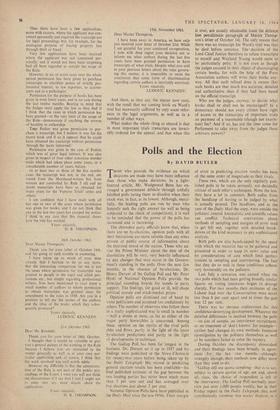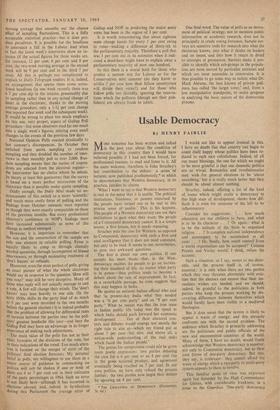Polls and the Election
By DAVID BUTLER
THOSE who ppovide the evidence on which decisions are made may have more influence than those who make decisions. In a light- hearted article, Mr. Wedgwood Benn has en- visaged a government debacle through artfully falsified polls luring them to-dissolve when their stock was, in fact, at its lowest. Although, merci- fully, the leading polls are run by men who honestly seek the right answer (as well as being subjected to the check of competition), it is well to be reminded that the power of the polls has increased and is increasing.
The shrewdest party officials know that, when there are no by-elections, opinion polls with all their limitations are more reliable than any other private or public source of information about the electoral mood of the nation. Those who ad- vise the Prime Minister about the date of the dissolution will be very, very heavily influenced by any changes that may occur in the Govern- ment's standing in the polls. Over the next few months, in the absence of by-elections, Dr. Henry Durant of the Gallup Poll and Mr. Peter Hyett of National Opinion Polls provide the principal sounding boards for trends in party support. The findings, for good or ill, will shape political morale and stock-market prices.
Opinion polls are dismissed out of hand by some politicians and accepted too credulously by others. The number of observers who follow them in a really sophisticated way is small in number —half a dozen at most, as far as either of the major party hierarchies is concerned. Among these, opinion on the merits of the rival polls ebbs and flows, partly in the light of the latest by-election predictions and partly in the light ol developments in technique.
The Gallup Poll has been far longest in the business. Dr. Durant set it up in 1937 and his findings were published in the News. Chronicle for twenty-two years before being taken 'up by the Daily Telegraph. His record in predicting general election results has been creditable—his final published estimate of the gap between the two leading parties has never been much more than 3 per cent out and has averaged over five elections just about 2 per cent.
National Opinion Polls have been published in the Daily Mail since the late 1950s. Their margin of error in predicting election results has been of the same order of magnitude as their rivals.
These two, which are the only regularly pub- lished polls to be taken seriously, are decidedly critical of each other's techniques. None the less, they have a lot in common. Both suffer from the handicap of having to be judged by what is actually printed. The headlines, and in the case of the Daily Mail the copy, were outside the pollsters' control. Journalistic and scientific values can conflict. Technical reservations about methods of sampling and margins of error tend to get left out, together with detailed break- downs of the kind necessary to any sophisticated analysis.
Both polls are also handicapped by the speed with which the material has to be gathered and presented in order to keep its news value and by considerations of cost which limit perfec-, tionism in sampling and interviewing. The fact that they do so well in these conditions reflects very favourably on the pollsters.
Last July a sensation was caused when the two polls which had been getting broadly similar figures on . voting intentions began to diverge sharply. For two months their estimates of the Labour lead over the Conservatives were never less than 8 per cent apart and at times the gap was 12 per cent.
There was no obvious explanation for this confidence-destroying development. Whatever the detailed differences in method between the polls — on size of sample, on interviewer recruitment, or on treatment of 'don't knows,' for example--- neither had changed its own methods. Intensive investigation by the pollsters themselves as well as by outsiders Tailed to solve the mystery.
.During October the discrepancy diminished and their findings have been broadly in agree- ment • for the last two months---although, strangely enough, their methods now differ more than they used to do.
Gallup still use quota sampling—that is to say, subject to certain quotas of age, sex and, above all, class, the choice of respondent is left to the interviewer. The Gallup Poll normally inter- view just over 1,000 people weekly, but in their Friday report in the Daily Telegraph they now .system'atically combine two weeks' findings, In 3
moving average that smooths out the chance effect of sampling fluctuations. This is a fully acceptable statistical practice—but it does pro- duce paradoxes. It is possible for the headlines to announce a fall in the Labour lead when in fact the latest week's interviews show an in- crease (if the actual figures for three weeks are, for instance, 12 per cent, 6 per cent and 8 per cent, the two-week moving average in the second week will be 9 per cent and in the third 7 per cent). All this is perhaps too complicated to explain to Daily Telegraph readers. It is, indeed, an arrangement that spares them some sensa- tional headlines (in one week recently there was a 7 per cent dip in the returns, presumably due to sampling rather than to any actual change of heart in the electorate; thanks to the moving average procedure, only a 1-11 per cent change was reported that week and the subsequent week). It would be wrong to place too much emphasis on this one, very proper, aspect of Gallup Poll procedure—but some observers read far too much into a single week's figures, relating even small changes to the events of the previous few days.
National Opinion Polls reacted drastically to last summer's discrepancies. In October they switched from quota sampling to random sampling and they doubled the number of inter- views in their monthly poll to over 2,000. Ran- dom sampling means that the names of respon- dents are selected from the electoral register— the interviewer has no choice whom he selects. In theory at least this guarantees that the survey is based on a more perfect microcosm of the electorate than is possible under quota sampling.
Oddly enough, the Daily Mail made no an- ' nouncement of this switch to a more 'scientific' and much more costly form of polling and the findings from October onwards were reported as though they were exactly comparable to those of the previous months. But every professional observer's confidence in NOP's findings must - have increased substantially as news of this change in method emerged.
However, it is important to remember that the size and the construction of the sample are only one element in reliable polling. Error is equally likely to creep in through clumsily worded questions, through incompetent or biased interviewers, or through misleading treatment of `don't knows' or refusals.
Moreover, even the most perfect of polls, giving an exact picture of what the whole electorate Would say in response to the question 'How will You vote?' may still be very deceptive. Many of those who reply will not actually manage to cast a vote. A few will change their minds. The 'don't knows' may lean heavily to one side. (In the early 1950s shifts in the party lead of as much as 9 per cent were recorded in the two months before the general election.) It is indeed probable that the problem of allowing for differential rates of turnout between the parties may be the poll- sters' greatest headache this year—and here the Gallup Poll may have an advantage in its longer experience of making such adjustments. The main value of the polls lies not in their exact forecasts of the divisions of the vote, but in their indications of the trend. Too much atten- tion is focused on the margin of error of the Pollsters' final election forecasts. My personal belief in polls, my willingness to use them as a major source of guidance in commenting on Politics will not be shaken if one or both of them are 4 or 5 per cent out in their estimates of the party percentages in 1964. Such an error is not likely here—although it has occurred in elections abroad, and, indeed, in by-elections during this Parliament the average error of Gallup and NOP in predicting the major party votes has been in the region of 3 per cent.
It is worth remembering that about eighteen seats change hands for every 1 per cent swing in votes—making a difference of thirty-six in the parliamentary majority. Therefore a poll that was 3 per cent out in its estimates when it indi- cated a dead-heat might have to explain away a parliamentary majority of over one hundred.
In this there is a moral both for those who predict a narrow win for Labour or for the Conservatives next summer (do they know to within 1 per cent how their fellow countrymen will divide their votes?) and for those who follow polls too slavishly, ignoring •the reserva- tions which the pollsters (though not their pub- lishers) are always frank to admit.
One final word. The value of polls as an instru- ment of political strategy, not to mention public information or academic research, does not lie principally in crude voting forecasts. Sample sur- veys are sensitive tools for research into what the electorate knows, into what it thinks on leaders and on issues, and into how it reacts in detail to attempts at persuasion. Surveys make it pos- sible to identify which sub-groups in the popula- tion are most moved by particular anxieties and which. are most amenable to conversion. It is thus possible to go some way to isolate what Dr. Mark Abrams, the best known of private poll- sters, has called 'the target voter,' and, from a less manipulative standpoint, to make progress in analysing the basic nature of the democratic process.



































 Previous page
Previous page